Vol 3 No. 25 TROPIC LIGHTNING NEWS June 17, 1968
Index
| Unit Page | Unit Page | Unit Page | Unit Page |
| 1st Bde S-5 7 | 2/14 1 | 25th Med. Bn 7 | 4/23 4 |
| 1/5 1 | 2/14 3 | 3/13 Arty 6 | 4/23 Photos 4 |
| 1/5 Photo 1 | 2/14 6 | 3/17 Air Cav 1 | 4/23 8 |
| 1/5 6 | 2/14 Photo 6 | 3/22 Photo 3 | 4/23 Photo 8 |
| 1/5 6 | 2/14 7 | 3/22 6 | 49th ARVN 1 |
| 1/5 8 | 2/22 1 | 3/22 8 | 6/77 Arty 6 |
| 10 ARVN Cav 1 | 2/27 7 | 4/9 7 | METRO 3 |
| 11th Cav 4 | 2/34 Armor 6 | 4/23 1 | METRO Photo 3 |
New Cayuse LOH; Tailor-Made for Recon
1ST BDE - Darting in every direction just above the tree tops, an
unusual helicopter is being used to supply the 25th Inf Div with tactical
information on Viet Cong locations and movements.
The unusual chopper now in use by the 3rd Sqdn, 17th Air Cav, supporting the 25th Div, is the OH-64 Cayuse light observation helicopter.
The Cayuse is tailor-made for aerial reconnaissance. The
light weight scout ship carries a three man crew - the pilot, an observer and
one door gunner. Each has a separate job, but all three must work as a
cohesive team since their ship flies within range of enemy small arms fire.
MAJ Jerry Leadabrand of Greenwood. Neb., Commander of Trp C, 3rd
Sqdn. 17th Air Cav, explained the mission of the Cayuse and its crew: "This is
strictly an observation helicopter and its mission is just that, reconnaissance
of land areas to observe and report enemy positions and movement."
"Although the Cayuse was not built to be a war-rager it does have
somewhat of a ferocious look about it when you see the six-barreled mini-gun it
carries for self-defense. The mini-gun can fire up to 2,000 rounds per
minute, related SGT David Scott, a 22-year-old observer from Max Meadows, Va.
As the Cayuse crews fly their dangerous mission just above the
ground they are never alone. On every mission by the small scout ship, a
fast and sleek Huey gunship circles overhead to supply protection if the little
chopper draws ground fire.
If the Cayuse draws fire the crew drops a smoke grenade and clears
the area. Then the hovering gunship crews sweeps down firing rockets and
miniguns. As a safety precaution, the scout ship has duel controls; in
case the pilot is hit the observer can fly the ship back. The observers
are usually not trained pilots, but each pilot attempts to give his observer
training so if the occasion does arise, the observer can bring the ship home.
The Cayuse crews direct air strikes and make damage assessments
after bomb runs. All sightings by the Cayuse are radioed to the guship for
transmission back to the troop's headquarters.
When infantry units begin operations in a new location, they know
what their new geographic area consists of and what size enemy force to expect,
thanks to the information from the Cayuse flights.
5th Mech Snuffs Out NVA Attack
2ND BDE - Two battalions of the 5th North Vietnamese Regt lost at
least 34 dead when they launched an abortive rocket, mortar and ground attack on
the night location of the 1st Bn (Mech), 5th Inf.
Standing firm behind a wall of artillery, gunship and tactical air
support, the 25th Inf Div soldiers took nine wounded in the heavy fighting 15
kms northwest of Cu Chi.
LTC Thomas C. Lodge of Deland, Fla., said ambush patrols set up
around his unit's forward base also took a heavy toll on enemy attempting to
join the battle, preventing any major ground assault on the defensive position.
Although patrols and listening posts had earlier reported numerous
sightings and movement, the action first began when enemy gunners unleashed a
100-round mortar barrage on the battalion base.
Following the midnight bombardment, North Vietnamese who had lined
hedgerows surrounding the battalion's location began pouring RPG rocket fire
at the U.S. troops, although none of the 40 recorded RPG's managed to score
direct hits either on bunkers or tracked vehicles.
When the first enemy assault came the 2nd Bde infantrymen opened
fire with .50 caliber machine guns, automatic weapons, grenade launchers and
mortars.
Air Force AC-47 flareships illuminated the open rice paddies around
the 5th Inf's position, making easy targets of the 10-man enemy assault
groups.
Gunships called in from the division base camp at Cu Chi
encountered heavy anti-aircraft fire, but escaped damage during strafing runs
over enemy positions.
One "Bobcat" ambush patrol positioned near the forward base
engaged an enemy company moving into the attack, killing with small arms,
grenades, and mortar and gunship support at least 10 enemy and blocking the
route to the beseiged Tropic Lightning battalion.
Heavy fighting continued for more than an hour, then slacked off
into sporadic exchanges of fire throughout the night.
At daylight, 5th Inf units sweeping the battlefield found 34 dead
enemy, plus heavy blood trails indicating more enemy had been badly wounded in
the attack.
The troops also captured eight RPG rocket launchers, one .30
caliber machine gun, six AK-47 assault rifles, 38 Chicom hand grenades and
hundreds of pieces of web gear, gas masks and other equipment.
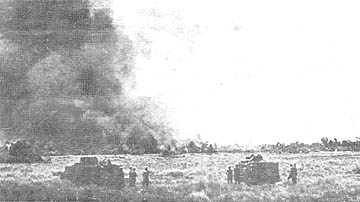 |
WAITING IT OUT - An Air Force jet pulls away from the enemy trenchline it just bombed while troops of the 25th Inf Div's 1st Bn (Mech), 5th Inf, wait to assault the North Vietnamese held position 38 kms northwest of Saigon. The action occurred during an Operation Toan Thang reconnaissance in force mission. |
Airborne Halts VC
1ST BDE - A two day battle with constant artillery support netted
elements of the 25th Inf Div 17 dead enemy and 6 detainees during a heated
battle in Operation Toan Thang 30 kms northwest of Saigon.
Co's A and C of the 2nd Bn, 14th Inf, defeated the enemy while
probing the banks of the Saigon River in the northern Filhol Plantation.
The companies suspected trouble after Co C's lead man, PFC Samuel
L. Brister of Durant, Okla., spotted enemy weapons and supplies near a tunnel
entrance. The discovery was relayed to the rest of the men and a careful
search of the area was made.
"I called for 'Airborne' and he came around my side and
walked up on three 'Charlies'," said Brister.
"They were lying there resting and when they spotted me, one of
them reached for his AK-47," recalled PFC David J. Galvond of Jonesboro, Ga.,
(nicknamed 'Airborne'). "I flipped my safety switch and aimed my
M-79 grenade launcher at him. He moved his hand back and held his hands up
like the other two," added Galvond.
After the three detainees were evacuated, Co C came under heavy
fire from enemy small arms as they continued their search.
Artillery was called in on the enemy as the infantrymen of the
"Golden Dragon" battalion continued their fight. By late afternoon the
enemy had stopped firing and the Tropic Lightning troopers set up a night
perimeter and kept a close watch on the area as artillery constantly struck the
enemy positions.
The next morning the soldiers of Co's A and C made on-line
assaults against the battle-scarred area and detained three more enemy suspects
as they took account of the numerous enemy losses.
A total of 17 dead enemy, 6 detainees including one officer, one
12.7mm anti-aircraft Chinese Communist machine gun, one 75mm recoilless rifle,
three light personnel machine guns and 10 AK-47 assault rifles were the result
of the two day operation. In addition, 2 complete 60mm mortars, Chinese
Communist carbines, and various small arms ammunition and supplies were
captured.
Tigers Team Up, Hit Cong Near Cu Chi
1ST BDE - While on a reconnaissance in force operation 15 kms
southeast of Cu Chi, the U.S. and ARVN 25th Inf Div's joined forces to kill 99
Viet Cong in two days of fierce fighting.
When LTC A.S. Fullerton, Commander of the 4th Bn, 23rd Inf,
received word that the 3rd Bn, 49th ARVN Regt was in contact with an estimated
VC Bn, the "Tomahawks" responded immediately and moved to reinforce the ARVN
force.
The fire was so intense it was impossible to penetrate the enemy
positions, and everyone pulled back while Fullerton directed a combination of artillery, mortars, gunships and air strikes upon the enemy positions.
After three hours of pounding, the Tomahawk s again attempted to breech
the enemy bunkers. But, they were well fortified bunkers and the enemy
seemed unharmed and again opened up with an even heavier volume of automatic
weapons fire. All the friendly forces again pulled back and more air
strikes were called in.
Late in the afternoon another daring assault was made on the enemy
positions. With their armored personnel carriers deployed on line, the
third platoon of Co B reached the enemy woodline where the blistering fire-fight
continued. As darkness fell, the Tomahawks withdrew to within 200 meters
of the woodline and set up a night defensive perimeter. Artillery, mortars
and air strikes pounded the enemy base camp through the night to prevent his
retreat under the cover of darkness.
At dawn the 4th Bn, 23rd Inf, the 3rd Bn, 49th ARVN Regt and a
troop from the 10th ARVN Cav deployed on line and assaulted the once impregnable
woodline. Sporadic enemy fire cracked during the assault but was quickly
silenced by the determined Tomahawks and ARVN's.
The result of the fierce two day fire fight was 99 enemy killed and
five more captured. The Tomahawks also captured 21 AK-47's, 10 Chicom
Carbines, seven RPG-2 launchers, 10 RPG-2 rounds, 25 82mm mortars, numerous
Chinese grenades and 34 complete North Vietnamese Army field packs.
'CIB' To Old Lady
3RD BDE - A Vietnamese woman inadvertently caught in a firefight
earned her Combat Infantryman's Badge in the eyes of the men of the Recon Plt,
2nd Bn (Mech), 22nd Inf.
"The old woman, who frequently sells soft drinks to the 3rd Bde,
25th Inf Div platoon as it sweeps the roads from Dau Tieng to Tay Ninh, was
caught up in the firefight when a Viet Cong force opened up on the "Triple
Deuce" sweep team with RPG rockets.
While the firefight raged, she gamely huddled on the side of the
road behind one of the platoon's armored personnel carriers, reloading M-16
magazines as they were handed to her, then tossing them back to the troops.
During the middle of the battle one G.I. jokingly asked whether he
could buy a Coke. Looking up briefly from her magazines, the old woman
coolly. responded, "No sweat, G.I., Cokes free today!"
Page 2 TROPIC LIGHTNING NEWS June 17, 1968
Decorated
| Bronze Star Medal (Heroism) | |
|
SSG Curtis Week, MACV Advisory Team 90 1LT Peter C. Mary, Co A, 2d Bn, 22d Inf PFC Larry Robinson, Co B, 3d Bn, 22d Inf 1LT William C. Kemp, Co A, 1st Bn, 27th Inf SP4 Lucas J. Ventline, A Battery, 1st Bn, 8th Artillery SSG David E. Hicks, B Trp, 3d Sqdn, 4th Cav PFC Sammy W. Harvey, Co A, 1 st Bn, 5th Inf SGT James E. Harris, Co B, 4th Bn, 9th Inf SP4 Robert M. Berger, Co B, 4th Bn, 9th Inf SP4 Robert L. McKeever, Co A, 65th Engr Bn |
SP4 Ralph K. Hosey Jr., Co F, 50th Inf PSG Samuel Turner, A Trp, 3d Sqdn, 4th Cav PFC Terrence Kobulinsky, Co A, 4th Bn 1LT Anthony J. Hare, Co B, 2d Bn, 12th Inf PFC Kenneth A. Wedman, Co A, 4th Bn, 9th Inf SGT Johnnie .B. Smith, Co B, 4th Bn, 9th Inf SP4 Jessie R. Owens, Co A, 2nd Bn, 14th Inf SP4 Guy D. Miller, Co A, 25th Avn Bn SSG James D. Austin, A Trp, 3d Sqdn, 4th Cav 2LT Michael R. Hatalovsky, Co A, 4th Bn, 9th Inf |
|
Army Commendation Medal (Heroism) |
|
|
SGT Joseph H. Best, Co C, 2d Bn, 22d Inf SP4 Leslie A. Hicks, HHB, 25th Inf Div Arty PFC Robert W. Bell, Co A, 2d Bn, 22d Inf 1LT Emmett L. Taylor, HHC, 2d Bn, 14th Inf PFC John L. Eick, Co A, 2d Bn, 22d Inf 1LT Michael S. Tooke, Co D, 2d Bn, 14th Inf SP5 Andrew P. Owens, HHC, 2d Bn, 14th Inf PFC Filiberto Atkinson, Co A, 2d Bn, 22d Inf SSG Frank E. Harshell, Co D, 2d Bn, 14th Inf PFC Willie J. Harvey, Co A, 2d Bn, 22d Inf SP4 Roger G. Ritter, B Trp, 3d Sqdn, 4th Cav SP4 Joseph E. Hartz, Co D, 3d Bn, 22nd Inf SP4 John G. Heiselman, Co D, 3d Bn, 22d Inf SP4 Kenneth D. Gamble, Co D, 65th Engr Bn SP4 Larry V. Fuger, HHT, 3d Sqdn, 4th Cav 1LT Patrick Moretti, Co D, 65th Engr Bn 1SG Joseph E. St Pierre, Co D, 65th Engr Bn 1LT James K. Fitzek, Co D, 65th Engr Bn SGT George W. Jones Jr., HHC, 2d Bn, 27th Inf SP4 John Mc Clean, Co B, 3d Bn, 22d Inf PFC Harvey Long, Co C, 3d Bn, 22d Inf SP4 Daniel L. Juan, Co C, 3d Bn, 22d Inf PFC Allen C. Peteet, Co B, 3d Bn, 22d Inf SGT David A. Ash, Co B, 3d Bn, 22d Inf PFC Wilber C. Bolyard, Co B, 4th Bn, 9th Inf PFC Melven Thomas, Co C, 3d Bn, 22d Inf PFC John M. Golden, Co C, 3d Bn, 22d Inf 1LT Denneth J. Stewart, HHB, 2d Bn, 77th Arty PFC Eddie R. Phillips, Co B, 3d Bn, 22d Inf PFC John Hoffman, Co B, 4th Bn, 23d Inf PFC William E. Vaughn, Co B, 4th Bn, 23d Inf SP4 Stanislaw Domaszewicz, Co B, 23d Inf SP4 Charles Witty, B Trp, 3d Sqdn, 4th Cav CPT Rudrick E. Boucher, Co D, 25th Med Bn SP4 Jerry L. Walker, Co A, 2d Bn, 22d Inf |
PFC Francis E. Benton, Co B, 4th Bn, 23d Inf PFC Richard Alcott II, Co A, 2d Bn, 22d Inf PFC James A. Kardas, Co A, 2d Bn, 22d Inf SGT Ronald E. Patterson, Co D, 2d Bn, 14th Inf PFC Willis D. Morris, Co B, 4th Bn, 23d Inf SP5 Martin K. Register, HHC, 2d Bn, 14th Inf SP4 Jerry M. Bell, HHC, 2d Bn, 14th Inf SP4 Warren E. Rempe, HHC, 2d Bn, 14th Inf SP4 Floyd V. Leach, Co B, 4th Bn, 23d Inf SP4 Raul A. Rosales, Co B, 4th Bn, 23d Inf PFC Larry W. Brawley, Co B, 4th Bn, 23d Inf PFC Donald J. Cakora, Co B, 4th Bn, 23d Inf PFC Sammy L. Brewer, Co B, 4th Bn, 23d Inf PFC Brent Hust, Co B, 4th Bn, 23d Inf SSG George W. Davis, Co B, 4th Bn, 23d Inf 2LT Michael C. Long, Co D, 2d Bn, 14th Inf 1SG James R. Posey, Co D, 2d Bn, 14th Inf PFC Jerry C. Taylor, Co A, 2d Bn, 22d Inf SGT George Marovich, B Trp, 3d Sqdn, 4th Cav SGT Hubert Humphrey, B Trp, 4th Cav SP5 Barry J. Anderson, B Trp, 3d Sqdn, 4th Cav SP4 Gary W. La Barge, A Trp, 3d Sqdn, 4th Cav SP4 Alvin A. Owens, B Trp, 3d Sqdn, 4th Cav SP4 Paul S. Townes, B Trp, 3d Sqdn, 4th Cav SP4 Orville Fairley, B Trp, 3d Sqdn, 4th Cav SP4 James L. Anderson, B Trp, 3d Sqdn, 4th Cav SP4 Philip Deane, B Trp, 3d Sqdn, 4th Cav SP4 Charles E. George, B Trp, 3d Sqdn, 4th Cav SP4 James A. McCall, B Trp, 3d Sqdn, 4th Cav PFC Richard W. Carter, A Trp, 3d Sqdn, 4th Cav SP4 Raymond A. Kimberly, Co B, 2d Bn, 12th Inf SSG Lloyd L. Smith, HHC, 3d Bn, 22d Inf PFC Edward Beckwith, Co B, 3d Bn, 22d Inf PFC Ernest Menchaca, Co B, 3d Bn, 22d Inf |
Computerized Personnel System
1005 To 'Feast' on Your Records
Deep down in your heart, you must have known it would happen sooner
or later.
Well. it finally has: You are going to be computerized!
To be more precise, information contained in your personnel files
maintained in the division Adjutant General Section will soon be fed into a
computer called "UNIVAC 1005 Card Processor."
The result, said LTC Clarence A. Riser, division AG, will be a
faster, more accurate system of personnel accounting and management.
According to the AG, the accuracy will result from the fact that
fewer human beings will handle the data used to manage your personnel affairs.
As have many other Army divisions in the states and in Europe, the
25th Inf Div will soon receive its first computer and will then begin
operations under a new personnel management system called PERMACAP - Personnel
Management and Accounting Card Processor.
The computer will replace conventional card punch machinery
presently used in the AG Automatic Data Processing Section. (Simply
stated, the difference between a computer and a card punch machine is that the
former can answer yes-or-no questions and the latter cannot.)
When PERMACAP begins, automatic typewriters, called Flexowriters,
will be used to type division orders while simultaneously performating vital
information into a paper tape. The paper tape will be fed into the UNIVAC
1005 computer which will automatically update a set of punch cards containing
the data on all personnel assigned to the division. Information on the
punch cards can then be called forth at any time it is required.
Use of the paper tape eliminates many opportunities for errors to
creep into your records and insures that your records will be up-dated quicker,
said LTC Riser.
At present it is necessary for clerks to extract vital data
concerning MOS changes, promotions, proficiency pay changes and the like from
orders and record it on morning reports. The same data is then extracted
from morning reports and placed on punch cards.
(Three punch cards are presently, and will continue to be,
maintained on each soldier. They contain the minimal information needed to
manage his personnel affairs.)
LTC Riser has stressed that the new system will not initially
eliminate the need for preparing the morning report but will undoubtedly change
its use. It will be used to verify accuracy of personnel data, he said,
and will no longer be required above division headouarters level.
Why Drug Tour Out?
In recent months, the Armed Forces have received a great deal of
adverse publicity concerning the misuse of drugs by service personnel.
The tragedy lies not in the publicity, but in the fact that within
our ranks we have a few people who have so little regard for themselves and
their responsibilities that they voluntarily subject themselves to the
destructive effects of illicit drugs.
Regardless of the fact that only a very small number of personnel
in uniform abuse drugs, it is far too many. One serviceman abusing drugs
is one too many.
It doesn't matter which drug you are talking about - all of them
have a great destructive potential when taken for "kicks" rather than at the
direction of a trained physician and under medically prescribed conditions.
You would certainly not entrust your life or safety to the
irrational whims or reasoning of someone who is mentally ill. By the same
token, you should not want to entrust your life and safety to a man whose
judgement and responses have been dulled and deranged by the abuse of drugs of
any type.
The drug abuser is a menace to himself, his fellow servicemen and
his country. He has no place in the military where the lives of others and
the safety of our nation could be threatened by his irrational acts.
Our responsibility to our country and to each other is too great to
inflict the cancer of drug abuse on our bodies and minds. As thinking,
intelligent, responsible human beings, we should have too much self respect to
destroy our bodies and minds voluntarily with drugs such as LSD, marijuana or
heroin. (AFPS)
|
Mosquitoes
|
The TROPIC LIGHTNING NEWS is an authorized publication of the 25th
Infantry Division. It is published weekly for all division units in the Republic of
Vietnam by the Information Office, 25th Infantry Division, APO San Francisco
96225. Army News Features, Army Photo Features, Armed Forces Press Service and Armed
Forces News Bureau material are used. Views and opinions expressed are not necessarily
those of the Department of the Army. Printed in Tokyo, Japan, by Pacific Stars and
Stripes.
MG F. K. Mearns . . . . . . . . . Commanding General
MAJ Andrew J. Sullivan . . Information Officer
2LT Don A. Eriksson . . . . . Officer-in-Charge
SP5 Terry Richard . . . . . . . . Editor
SP5 Stephen Lochen . . . . . . Editorial Assistant
Page 3 TROPIC LIGHTNING NEWS June 17, 1968
EM Insignia Change; E-2s To Wear Stripe
Four hundred thousand enlisted men will be affected by the new
insignia changes announced by the Department of the Army.
By June 30, some 6,600 non-commissioned officers in pay grades E-5,
E-6 and E-7 will change insignia. The NCOs are currently wearing insignia
one grade higher than their actual grade.
A private in the pay grade E-2 is now authorized one stripe, the
insignia formerly of private first class. The private first class will
wear one stripe above one arc.
The changes in private E-2 and E-3 will also be completed by June
30. More than 146,000 privates in grade E-2 will get the stripe and
231,000 privates in grade E-3 will change insignia.
The mandatory changeover for NCOs does not represent a reduction in
grade. The individuals involved will continue in their present pay grade
and retain those privileges and benefits of that grade.
The changeover resolves a problem of dual
insignia for grades E-5, E-6 and E-7 which has existed for 10 years. Now all NCOs will wear
insignia that is actually representative of their grade.
The problem of dual insignia began on June, 1958, when new insignia
for E-5 through E-7 were authorized as part of the pay grade structure change
that established pay grades E-8 and E-9. All NCOs were allowed to keep
their stripes although they indicated a grade above their actual pay grade.
New insignia for privates should be available within the month.
| CROSSING - Members of Bravo Co, 3rd Bn, 22nd Inf, use an abandoned sampan to make a dry crossing in rice paddies as the 3rd Bde, 25th Inf Div, soldiers are on operation south of Cu Chi. | 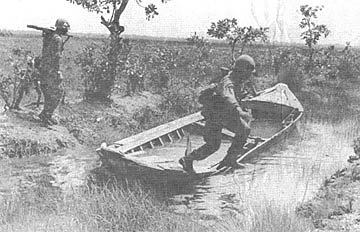 |
Put More Than Bags On Bunker
With the advent of the monsoon season the importance of proper
bunker design cannot be overstressed. Heavy rains increase the weight of
sandbag roofs and undermines foundations and may collapse the bunker.
A common error is to use only sandbags and filled ammo boxes to
support overhead cov er. While these materials are suitable for wall revetments
they should be used with timber or matting for adequate overhead protection.
Moreover, when PSP or M8A1 matting is used it should be supported
on 24" centers by adequate-sized timber in order to properly support sandbag
roofs.
Finally, timber supports should be checked periodically and
replaced when necessary.
Be Sure To Heed Allotments
All personnel in the grades of E-4 (with under four years service)
and below who have dependents are required to support those dependents with a
Class Q allotment.
Members in grades E-4 (with over four years service) and higher are
not required to provide support by allotment; but, when a member is promoted to
E-5 or completes four years service as an E-4, his Class Q allotment will be
terminated by the finance officer and a Class E allotment will be initiated in
the same amount. This amount is subject to the service member's
approval.
If the member desires other arrangements he must report in person
to his finance office to initiate the desire action.
Yellow VC
1ST BDE - "Suddenly, a bright yellow hand emerged from the tunnel
and three NVA soldiers came out looking like someone had sprayed yellow paint
all over them," recalled 2LT Douglas Miller of Vancouver, Wash.
The 25th Inf Div's 2nd Bn, 14th Inf, was on a reconnaissance in
force mission 54 kms northwest of Saigon when a flankman spotted a body in a
tunnel entrance.
"I went down in the hole and saw two others move back in the
tunnel," said PFC Damon Darley of Seattle, Wash.
The Vietnamese interpreter with the unit told the enemy soldiers to
come out and the American medic would treat their wounds, but they refused to
answer.
"Finally, when they wouldn't answer, and we could see they
weren't going to come out on their own we decided to throw a yellow smoke
grenade in the tunnel to see if it would drive them out," Miller said.
They came out - slightly yellowed, but unharmed.
What Is Joy? Being Alive!
Joy is a stringer full of fish and the smile on a boy's face as
he lands his first big one. Joy is a pocket full of marbles, a piece of
string, three old buttons and a toy sheriff's badge. Joy is a dog at
your side, the sun in your face and an old side-by-side slung over your arm.
Joy is a brace of ducks and the cold wind biting your ears. Joy is a
cottontail dodging through the broom grass with a Beagle at his heels. Joy
is a poppin' bug with a lunker bass churning the water like a washing machine.
Joy is the smell of coffee and fried bacon mixed with early morning fog.
Joy is a trout suspended in mid-air with nothing between you and the trout but a
thin fly line. Joy is a man and his son digging for worms. Joy is a
big buck walking calmly by when the season is closed. Joy is a new rod and
reel, a tackle box, a John boat and a good stream with dead logs and plenty of
brush on the bank. Joy is spring and summer and just being alive.
Joy is a man who is in tune with nature and his fellow man. (Observer)
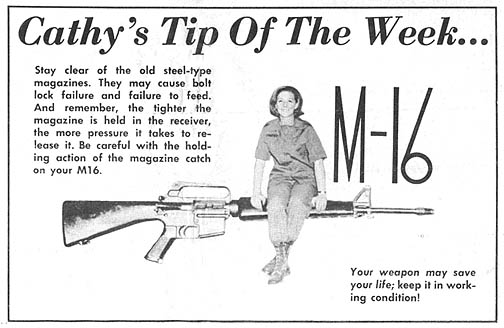 |
Page 4-5 TROPIC LIGHTNING NEWS June 17, 1968
Tomahawks Smash VC In Long Fight
1ST BDE - The 4th Bn (Mech), 23rd Inf, and a
Trp from the 11th Cav substantially aided the beleaguered town of Boa Trai, 12
kms southeast of Cu Chi base camp, from being overrun while on a reconnaissance
in force operation.
It was by the direct support of the 25th Inf Div force that the
besieged town was saved.
The 4th Bn, 23rd Inf Tomahawks were informed of the
precarious condition of Bao Trai just after midnight, and were dispatched to
relieve the pressure. By dawn, the Tomahawks were in contact with an
estimated VC battalion.
LTC A.S. Fullerton, CO of the Tomahawks, a firm believer in the use
of fire support, directed Alpha and Bravo companies to pull back as he directed
an artillery barrage and tactical air strikes onto the enemy positions.
Then with Bravo on one flank and the 11th Cav Trp on the other,
Alpha Co and the reconnaissance element spearheaded an assault.
The advancing unit had moved only 20 meters into the woodline
before the enemy opened up with a heavy volume of automatic weapons and RPG
fire. The .50 caliber machine guns barking and elements dispersing on line
between the armored personnel carriers, the determined Tomahawks overran the
poorly dug in enemy.
During the height of the fire fight, LTC Fullerton, flying over the
battlefield by helicopter, noticed an enemy squad retreating into an adjoining
woodline. Having swept over the first objective, the Tomahawks proceeded
to the noted woodline.
CPT Gordon R. Lam, Alpha Co CO, detained one VC for questioning and
the company found 10 enemy bodies in the immediate area. A sweep of the
entire battle area netted 35 enemy dead in addition to those already found.
The day's work completed and the threat to Bao Trai eliminated,
the Tomahawks moved on to other activity as a matter of course, but taking with
them the knowledge of the safety of the village and remembering the relieved
looks on the faces of the villagers.
|
PREPARING for the assault.
|
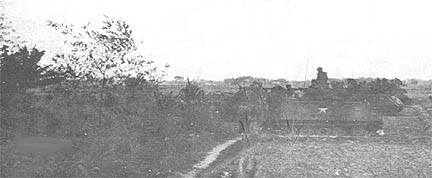 |
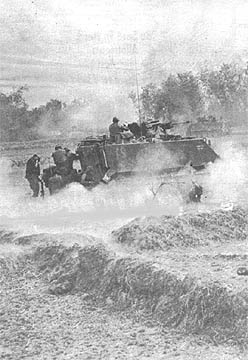 |
TAKING CAREFUL AIM, an infantryman of the 4th Bn, 23rd Inf, sights in on a Viet Cong bunker with a 90 mm recoilless rifle. |
|
INFANTRYMEN watch as a tactical air strike is directed on the enemy positions. |
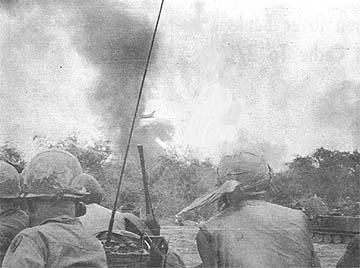 |
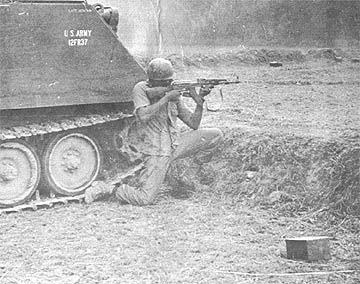 |
CHARLIE GETS A TASTE of his own medicine as a Tomahawk fires an AK-47 during the action. |
| TOMAHAWKS scramble off an APC as they receive sniper fire. | 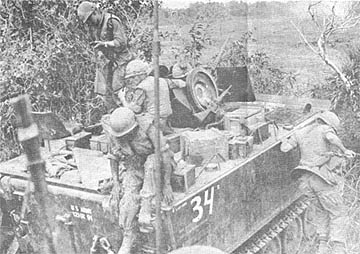 |
Page 6 TROPIC LIGHTNING NEWS June 17, 1968
Saigon River Banks Yield Cache To 2/14
1ST BDE - Heliborning into the banks of the Saigon River netted
elements of the 25th Inf Div a large number of enemy weapons during Operation
Toan Thang.
Two Chinese communist 75mm recoilless rifles, one Chinese communist
anti-aircraft machine gun, 13 Chinese communist light personnel machine guns and
20 AK-47 assault rifles, highlighted the cache uncovered 20 kms northwest of
Saigon.
Co D, 2nd Bn, 14th Inf, found the weapons at the edge of a canal
while conducting a reconnaisance in force mission in the northern Filhol
Plantation.
"Our platoon was walking point for the company and had only been
sweeping about an hour when my lead man came upon the weapons," said 3rd
platoon leader 1LT Michael C. Long of Mackeyville, Pa.
"I spotted some of the machine gun barrels facing toward me near
some trees. At first I figured we were surrounded by 'Charlie',"
remarked PFC Gerald W. Smith of Hesperia, Mich. "I kept a close eye on
the protruding barrels and called for Huber."
Long contacted the commanding officer of Co D, CPT Raymond C.
Dawson of Muskogees, Okla., and the Tropic Lightning soldiers set up security
and the cache was checked out.
By the time the choppers arrived for evacuation of the weapons,
another anti-aircraft barrel, 2 RPG-2 rocket launchers with rounds, 1 complete
82mm mortar with 4 rounds, 75 pounds of demolition explosives, 5 anti-tank mines
and other enemy supplies were also uncovered by the Golden Dragons.
After evacuation of the weapons, the men of Delta Company airlifted
back to their fire support base. "That's a few more weapons we won't
have to worry about facing," concluded SGT Clyde N. Mackins of Palaski, Ill.
Plt Blocks VC Help
2ND BDE - Elements of a 25th Inf Div recon platoon, surrounded by
enemy while its parent battalion was under heavy attack, successfully blocked a
North Vietnamese column of reinforcements from entering the battle.
SSG Leonard Charfacuros, 22, of Agana, Guam, said his ambush patrol
killed at least 10 North Vietnamese who were on their way to attack the base
camp at Cu Chi.
Charfacuros said his recon platoon had positioned itself around a
rice paddy a kilometer from the 5th Inf's night location 15 kms from the
division's base camp at Cu Chi.
Shortly after midnight, two battalions of the 5th NVA Regt began
pounding the U.S. battalion with a 150 round barrage of RPG rocket and mortar
fire. The enemy followed up the bombardment with repeated ground attacks.
Soon after the battle began, the ambush patrol spotted a heavily
armed enemy company moving towards the U.S. perimeter.
Charfacuros ordered his men to open fire with grenade launchers and
hand grenades, but forbade the use of rifles and machine guns to prevent a
compromise of the platoon's positions.
Hit "hard and confused," the enemy unit first scattered, then
began filtering in small groups by the recon platoon's perimeter.
At daybreak, Charfacuros led his platoon on a search of the area,
finding ten bodies and detaining one enemy suspect who attempted to escape.
As a result of the patrol's action, at least 10 North Vietnamese
were killed and two detained, although blood trails indicated more had been hurt
in the ambush.
Artillery Medcaps Roll In High Gear
CU CHI - Since resuming field operations after a pause during the
February Tet offensive, the 25th Inf Div Artillery Civil Affairs Section is
again rolling in high gear.
As part of a continuing medical civilian aid program (MEDCAP),
medical teams from the 6th Bn, 77th Arty and 3rd Bn, 13th Arty, and Headquarters
Battery, treated more than 2,000 men, women, and children in Trang Bang District
in March and April.
To combat the deadly menace of plague, the teams administered some
830 immunizations thereby helping to avert a possible epidemic.
When transportation was disrupted during Tet and procuring enough
food became a problem for the residents of Trang Bang District, Division
Artillery Civil Affairs Section turned over to district authorities 400 pounds
of rice and 200 pounds of fish which had been captured from the Viet Cong.
hey also provided 210 loaves of bread as well as dried potatoes, onions and
eggs.
To help the Regional Forces and Popular Forces strengthen their
installations, the Civil Affairs Section delivered over 3,000 powder canisters
to be utilized as bunker reinforcement or even as pipe line when welded
together.
Thirteen 21/2-ton truck loads of lumber were given to the Trang
Bang District Chief to be distributed to the Vietnamese. Over 100 bags of
cement, 120 tin roofing sheets, 325 coils of concertina wire, and 100 rolls of
barbed wire were also presented.
A donation warmly welcomed by mothers of the district was 160
pounds of soap and 48 bottles of baby oil.
You Can Take It With You
The battalion commander was speaking to his men: "The
pulling together, the reliance of men upon one another, the 'camaraderie' of
soldiers in war is unique among men. I've seen it on this operation and
I'm proud of it." The commander has noticed "it." Have you?
This comradeship of soldiers in combat is a model that the rest of
the world might favorably duplicate. Circumstances of warfare thrust aside
differences which don't really matter.
"How is he, sir? Will he be o.k.?" A worried
soldier, with badly injured legs, lay on a stretcher in a combat aid station.
He anxiously looked over to another stretcher. His great concern was not
for himself, but for a wounded buddy with different colored skin.
"Greater love than this, no man has, that he lay down his life
for his friend." Many a silver star for valor has been awarded
posthumously to soldiers who died trying to rescue a wounded soldier of another
race, or nationality, or religion.
Good is where you find it. Call it 'camaraderie' or
friendship, call it understanding or brotherly love, many soldiers have found
"it" in Vietnam. If you have been one of them, then for love of God
and country, don't leave it behind when you 'DEROS'. Bring it home.
Live it. Our country needs it now.
(By Chaplain (Cpt) Thomas R. Berberich).
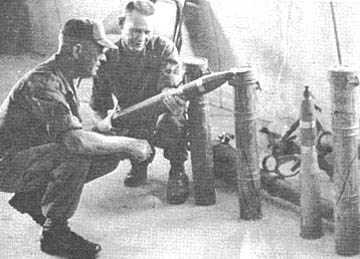 |
75 RECOILLESS CARTRIDGE - CSGM John Schafer of Hilleen, Texas (left), and SFC Robert Cooley of Opelika, Ala., examine one of the 75mm Chinese Communist cartridges found in a large weapon cache by the 2nd Bn, 14th Inf, 60 kms northwest of Saigon. |
1/5 Runs Down Assassins
Regional Force Leads Way
2ND BDE - Elements of the 1st Bn (Mech), 5th Inf, returning from a
reconnaissance in force aided members of a Regional Force unit in successfully
hunting down an enemy assassination team.
Co A and the battalion headquarters were on the way back to their
night location when they heard small arms fire to their south.
LTC Thomas C. Lodge, Deland, Fla., wheeled his battalion towards
the fighting, soon encountering a squad of the 198th Regional Force Co.
Through the company's interpreter, Lodge learned the squad was
chasing three Viet Cong who had seriously wounded the village chief of Vinh Loc,
Gia Dinh Province, six kms northwest of Saigon.
Lodge then told the RF soldiers to hop on board his armored
personnel carrier, and with the Vietnamese pointing the way, continued the
chase.
The combined force nabbed the first enemy in a wooded area.
The man had changed clothes, but the outfit he wore on the murder attempt was
still in his possession.
The 25th Inf Div soldiers detained the second would-be assassin
when he attempted to escape via his motorcycle. The RF squad leader
spotted the man, shouted for him to halt and then shot at him when the man fled
on foot into some roadside brush.
SP4 Dan Oberding, 20, of Seneca, Kan., a radio-telephone operator
with the 2nd Bde battalion, jumped off the command track and sprinted after the
Viet Cong. The 6-foot 2-inch tall Oberding caught the man after a brief,
one-sided foot race.
Further to the southeast, elements of Co A, 2nd Bn, 34th Armor,
detained the third member of the assassination party.
When all three were returned to Vinh Loc, villagers and ARVN
intelligence officers identified them as the killer team.
In addition, the man who attempted to mount the motorcycle was
identified as the executive officer of a local Viet Cong rifle company.
TOWELS: Multi-Purpose Gear
3RD BDE - Most people think of a towel as a good way to dry off
after a refreshing shower. To the men of the 3rd Bn, 22nd Inf however, the
O.D. towel is a valuable piece of field equipment with as many uses as the
trusty poncho.
Worn draped over the shoulders, the towel provides excellent
padding for their pack straps. On dusty convoys the 3rd Bde, 25th Inf Div
troopers utilize their towels as small arms cases that can be removed quickly in
case of attack.
As a "foreign legion" type headdress, the green towel provides
protection from insects and the elements.
Waiting for the right sortie on a landing zone is a lot more
comfortable with a handy towel to protect the face and neck from dust whirlpools
caused by the powerful Huey rotor blades.
When folded into a small square it becomes a soft pillow.
The men of the 3rd Bn, 22nd Inf also use their towels to dry off
after washing up, but even then the "Regulars" try not to get them too wet
since the O.D. towel is also useful when it's dry.
| GRANDMA? COUSIN? BROTHER? What kind of bird is that? Turkeys that roam freely around the 25th Inf's 1st Bde headquarters at Tay Ninh, curiously wonder about the questionable heredity of their mechanical counterpart. The turkeys were given to the 1st Bde by the Tay Ninh province chief. | 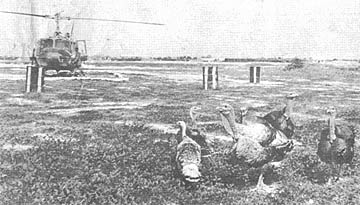 |
Page 7 TROPIC LIGHTNING NEWS June 17, 1968
25th Medical Battalion
Unit of The Week Plans Healthy Role
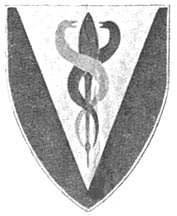 No one can say enough about the vital necessity of a professional,
expedient medical facility in this unpredictable conflict. The men who pit
their all explicitly towards the health and safety of our fighting soldiers in
Vietnam deserve every ounce of credit one can bestow.
No one can say enough about the vital necessity of a professional,
expedient medical facility in this unpredictable conflict. The men who pit
their all explicitly towards the health and safety of our fighting soldiers in
Vietnam deserve every ounce of credit one can bestow.
For they are the ones who assure the soldier in the field that he
is the most important asset the Army has: manpower.
The 25th Med Bn is made up of such men. Constituted into the
Army of the United States on August 26, 1941, it was assigned as a Tropic
Lightning unit. The unit was actuated at Schofield Barracks in Hawaii in
October first, 1941.
The 25th Med has a long and honorable history. As an organic
element of the 25th Inf Div, it served in the South Pacific during World War II,
gaining for itself the Philippine Presidential Unit Citation. The
battalion was awarded four campaign streamers for its participation in fighting
on Guadalcanal, the Northern Solomons, Central Pacific, and Luzon.
On June 27, 1949, the battalion was designated a Regular Army unit,
and when fighting broke out in Asia on June 25, 1950, the Med Bn moved to Korea
with the Tropic Lightning Div. It participated in the battles around the
Pusan Perimeter, Punchbowl, Heartbreak Ridge, Kumhwa, and Munsan-Ni. The
battalion was awarded another ten campaign streamers for battle participation in
the Korean conflict, two Republic of Korea Presidential Unit Citations, and the
Meritorious Unit Commendation.
The first elements of the battalion arrived in Vietnam in January,
1966. By March 31, 1966 the entire battalion had been transferred to
Vietnam. To date, elements of the unit are credited with participation in
operation Wahiawa, Makiki, Kahana II, Oahu Blue Jay. Junction City, and
Yellowstone, in addition to other unnamed operations.
On top of all this it conducts an aggressive Civic Actions program.
Companies of the unit are presently located in Cu Chi, Dau Tieng, and Tay Ninh.
LTC Rainer S. Pakusch, Bn Co., heads a unit that can be proud of
its record and its job.
5 Enemy Ambushed By 2/27;
Two NVA Officers Are Killed
2ND BDE - Two officers were among five North Vietnamese Army (NVA)
troops who walked into a recent 25th Inf Div ambush 15 kms northwest of Saigon.
Members of Co C, 2nd Bn, 27th Inf "Wolfhounds", reported
killing the five enemy after setting up at an enemy rendezvous point.
2LT David C. Rodgers, the platoon leader, said his men moved into
the ambush site along a canal bank after waiting for darkness during an
Operation Toan Thang reconnaissance in force.
Around 10 p.m. explained Rodgers, 22, of West Point, Ga.,
his men saw a sampan land downstream and three persons disembark. The trio
walked along the canal bank until they stopped in front of a Claymore mine.
SP4 Ernest L. Jackson watched one of the enemy light a cigarette.
Jackson, 23, of Coleman, Tex., ordered his squad to detonate the claymore,
killing all three.
Six hours later, the platoon engaged with automatic weapons and
grenades a pair of enemy who walked by the ambush site.
A sweep the next morning revealed the five North Vietnamese and six
automatic weapons. Identification papers indicated two of the men had been
NVA officers, Rodgers said.
Volunteers Team Up To Hit Rocket Base
1ST BDE - Three 25th Inf Div soldiers who by day staff the 1st
Bde's S-5 section, teamed up at night to neutralize an enemy rocket position.
Voluntarily moonlighting as forward observers (FO's) atop a 147
foot tower in nearby Gao Xa village, SSG John Gilber of Quincy, Fla., and SP4
Richard Kreutzberg, of Yonkers, N.Y., worked with their Civic Action officer CPT
F. L. Fly who was on duty at the Tactical Operations Center in Tay Ninh base
camp. The team called in artillery fire moments after the first rocket was
launched but before any damage or casualties were taken.
The incident occurred when an ARVN interpreter working with the 1st
Bde soldiers spotted a 122mm rocket being launched by the VC. He
identified the position and Kreutzberg called in the location to Fly, a native
of Nashville, Tenn.
Seconds later Gilbert and the interpreter spotted three more
rockets being launched, two of them from another position. As the rockets
slammed into the base camp, Kreutzberg was again in contact with Fly, giving him
the position of the other launch site.
As the Civic Affairs officer was calling in artillery to hit the
position, Gilbert manned a .50 caliber machine gun mounted on the tower.
Although one of the launch sites was 1,500 meters away, Gilbert, who was
assisted by a Kit Carson scout, Dau Van Ut, was on target.
Moments later the FO team watched artillery pound the area.
"You can bet the VC were planning to send in more rockets,"
said Kreutzberg later. "But either we hurt him or scared him off,
because Charlie didn't launch any more after we hit his site."
According to Fly, a leader of Cao Xa village requested that
American troops equipped with a radio be placed in the tower as a counter mortar
and rocket team. Realizing that from the tower one can detect rocket and
mortar flashes for miles around, Fly asked his section for volunteers.
Everyone volunteered. Fly, SSG Donald Haynes, another Civic
Action NCO, Kreutzberg and Gilbert have all stood watch on the tower.
Summing up how he feels about the team's continuing vigil,
Gilbert said, "I just sleep better knowing that our men are up there.
And Father Dzu tells me that his people of Cao Xa feel the same way."
VC Bunkers Don t Stop Co A, 4/9
1ST BDE - The 25th Inf Div's 4th Bn, 9th Inf, killed 23 Viet Cong
with the aid of artillery and airstrikes, nine miles northwest of Saigon.
Co A made an airmobile assault, and as they jumped from their
choppers on the landing zone the Manchu infantrymen were greeted by a hail of
heavy automatic weapons fire. Using the tremendous firepower at his
disposal, CPT Elcie Adams called in artillery and airstrikes upon the enemy
positions. When the artillery lifted the Manchus quickly pushed into the
woodline.
The Viet Cong were in well-fortified bunkers and still putting up
strong resistance. SP4 Robert Tafoya of the 2nd Pit, firing his 90mm
recoilless rifle, blew apart several VC bunkers, killing three enemy.
Raking the area with machine gun fire the Manchus killed several more VC as they
fled their bunkers.
Encountering no more resistance, the Co A soldiers swept the area
and found 23 dead VC, 4 AK-47s, 1 Chicom carbine, 2 sights for the 122mm rocket,
and 500 rounds of AK-47 ammunition.
2/14 Shows That Three's A Charm
1ST BDE - Someone once said, "Third time's charmed."
And 1LT John R. Smith, a 25th Inf Div artillery forward observer (FO), now
believes it.
Smith, an FO with Co C, 2nd Bn, 14th Inf, and the battalion
commander, LTC Thomas Nunn, were in an OH-23 light observation helicopter over
the Filhol Plantation 32 kms northwest of Saigon when they received a radio
message telling them that "Charlie" was firing 122mm rockets at the 25th
Div's Cu Chi base camp.
"Just as we received the message, our pilot pointed out the flash
from the rockets as they headed for Cu Chi," Nunn recalled.
"I hadn't been in country very long, but the terrain features
gave me a good idea of the location so I did my best. The first couple of
rounds made the VC scatter as we flew lower to take a closer look, but boy that
third one really did the trick," said Smith of Bakersfield, Calif.
"The third one was the charm all right. I'll guarantee
you that 'Charlie' got the surprise of his life and that was the last of his
rocket activities," added Nunn of Henryetta, Okla.
Quick action by the trio put a halt to the early evening rockets as
the rocket site went up in flames when the third shell from the big guns made a
direct hit and set off a secondary explosion.
Page 8 TROPIC LIGHTNING NEWS June 17, 1968
Regulars MEDCAP Tay Ninh
3RD BDE - Using a Huey as transportation, a medical team from the
3rd Bn, 22nd Inf of the 3rd Bde, 25th Inf Div, flew into Tay Ninh Province for a
MEDCAP.
Under the direction of the battalion surgeon, CPT Ira P. Mersack,
the "Regulars" medics treated over 300 patients in the hamlet of Suoi Can
during the afternoon project.
This turnout was the largest yet for a medcap in this heavily
populated district, where the previous week had seen only half as many villagers
attend the afternoon clinic.
"We will be coming to one of the hamlets in this district every
week," commented Mersack; "eventually we hope to establish a
tuberculosis clinic and an immunization clinic here."
General Mearns Decorates Tomahawks
1ST BDE - MG F.K. Mearns, 25th Inf Div CG, recently visited the 4th
Bn (Mech), 23rd Inf "Tomahawks" here, to decorate members of the battalion.
With old glory and the battalion colors waving in the breeze and
the Tomahawks locked in the position of attention, GEN Mearns arrived at the
presentation ceremony. Walking through the ranks, he decorated several men
for valor and to each one extended a sincere hand of congratulations.
With the presentations completed, the Commanding General addressed
the decorated men. In part, he pointed out his pride in them and his
desire to decorate them all with the Medal of Honor, as they were probably
deserving of this high tribute. He also remarked that he would like to
decorate each and every Tomahawk and finally extended to each soldier a sincere
commendation on a job well done.
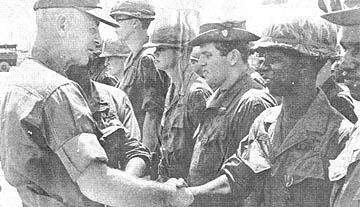 |
| CONGRATULATIONS! - MG F.K. Mearns, 25th Inf Div Commander, congratulates Tomahawk SP4 Elmo Overton of Norfolk, Va., after presenting him with the Bronze Star for Valor. |
Artillery Must Rely On METRO's Private War
1ST BDE - In order to be on target, artillery units must place
accurate data on their guns. One of the factors that must be taken into
consideration when computing firing data is the prevailing weather conditions.
Because a significant change in air density, wind direction, or
wind velocity can result in a firing error if not accounted for, artillery units
at Tay Ninh base camp greatly depend upon the weathermen of the Meteorological
Observation (METRO) station.
At Tay Ninh, the team of men who staff METRO work around the clock
keeping a constant surveillance on changing weather conditions. The II
Field Force unit is commanded by WO Harold J. McLaughlin, Jr., of Escanaba,
Mich.
The method of gathering meteorological information was explained by
SSG Thomas R. Murdock of Fairfield, Calif., "We periodically send u p weather
balloons with a radiosonde (battery operated transmitter) attached to it.
As the balloon begins its upward flight, the transmitter then begins relaying
information to the METRO station. Also, as the balloon ascends it is
followed by an automatic tracking device."
The reports sent back to the station are then broken down into two
groups. Computer data is sent to the Air Force weather station.
Ballistic data, such as temperature, density, wind direction, and wind velocity
is then checked, charted, and immediately forwarded to artillery fire direction
centers.
| READY FOR LAUNCHING - Member of METRO (Meteorological Observation) are ready to release a weather balloon with its transmitter, on its "weather data" collecting flight. | 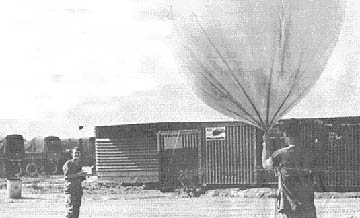 |
NVA Camp Destroyed
2ND BDE - A reinforced mechanized company of the 25th Inf Div
fought through thick terrain and overran a North Vietnamese battalion-size base
camp, killing at least seven enemy and capturing their weapons.
Co B, 1st Bn, 5th Inf, then called in demolition experts to destroy
46 reinforced bunkers and nine fighting positions in the enemy installation 11
kms northwest of the 25th Div's base camp at Cu Chi.
The Tropic Lightning troopers made contact around mid-morning while
pushing through dense underbrush and trees on the edge of the HoBo Woods.
A heavy prep of artillery, tactical air strikes and mortar fire
failed to drive the North Vietnamese completely from the camp. As Co B
moved in, heavy AK-47 fire erupted from several fighting positions.
Armored personnel carriers crashed through the brush and blasted
fire lanes for the dismounted "Bobcat" troopers.
The ground soldiers then advanced, pouring anti-tank rockets and
automatic weapons fire on the enemy bunkers. By noon, the North Vietnamese
force deserted its complex, leaving behind seven dead and four AK-47 assault
rifles, an RPG-2 rocket launcher and a collection of medicine, web gear and
personal equipment.
Inside the complex, the Operation Toan Thang infantrymen found
several incomplete bunkers, new NVA uniforms and building equipment. Rice
was still warm in several cooking pots.
Battalion demolition men used plastic explosives to demolish the
North Vietnamese complex.
There were no U.S. casualties reported in the fighting.
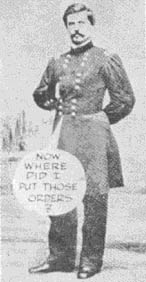 |
It's A Regulation Current regulations of all services prohibit the display of any flag, pennant or emblem on official vehicles or for official purposes unless specifically authorized by AR 840-10. Individuals may have in their possession state flags, personal flags, pennants or emblems etc. for their own personal use only. Display of state flags, pennants or emblems etc. on U.S. Army vehicles of any type, or outside U.S. Army buildings is considered official in purpose and therefore not authorized. |
Thanks to
Don Casteel, 2nd Bn., 14th Inf. for sharing this issue,
Kirk Ramsey, 2nd Bn., 14th Inf. for creating this page.
This page last modified 8-12-2004
©2004 25th Infantry Division Association. All rights reserved.